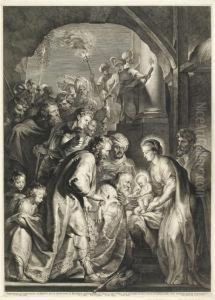Lucas Vosterman Paintings
Lucas Vorsterman was a prominent Flemish engraver and draughtsman known for his masterful reproductions of the works of leading Baroque artists of his time, such as Peter Paul Rubens, Anthony van Dyck, and others. Born in Zaltbommel, in the Dutch Republic, in 1595, Vorsterman's early life is somewhat obscure, but he is thought to have been apprenticed to the engraver Cornelis Galle the Elder. His considerable skill soon attracted the attention of Rubens, who took him under his wing in Antwerp. Under Rubens' guidance, Vorsterman became a key figure in translating Rubens' dynamic compositions into engravings, which played a significant role in spreading the fame of Rubens' works throughout Europe.
Vorsterman's relationship with Rubens, however, was fraught with tension, reportedly due to the intense pressure and exacting standards Rubens demanded. This led to a falling out between the two, and Vorsterman subsequently worked more closely with van Dyck, engraving many of his portraits. Despite the difficulties with Rubens, Vorsterman's work from this period is considered some of the finest examples of engraving of the era, characterized by its technical skill and the ability to convey the emotional depth and complexity of the original paintings.
In the 1620s, seeking to expand his opportunities, Vorsterman traveled to England, where he engraved works after van Dyck and other artists at the court of Charles I. His work in England further cemented his reputation as a master engraver. Upon returning to Antwerp, he continued to produce engravings after various artists and also created original works. Throughout his career, Vorsterman contributed significantly to the dissemination and popularity of Baroque art, making it accessible to a wider audience through his engravings.
Lucas Vorsterman died in Antwerp in 1675. His legacy includes not only his own extensive oeuvre but also his influence on the art of engraving in the 17th century. His son, Lucas Vorsterman II, also became an engraver, continuing the family tradition. Today, Vorsterman's engravings are highly valued by collectors and are studied for their technical excellence and their role in the art historical narrative of the Baroque period.

